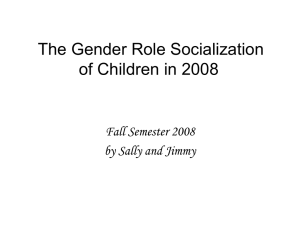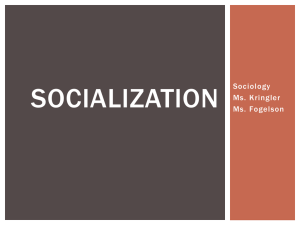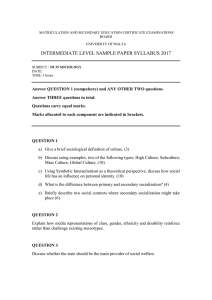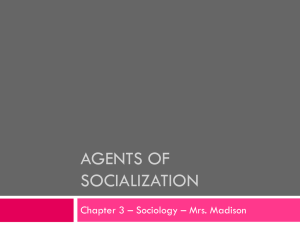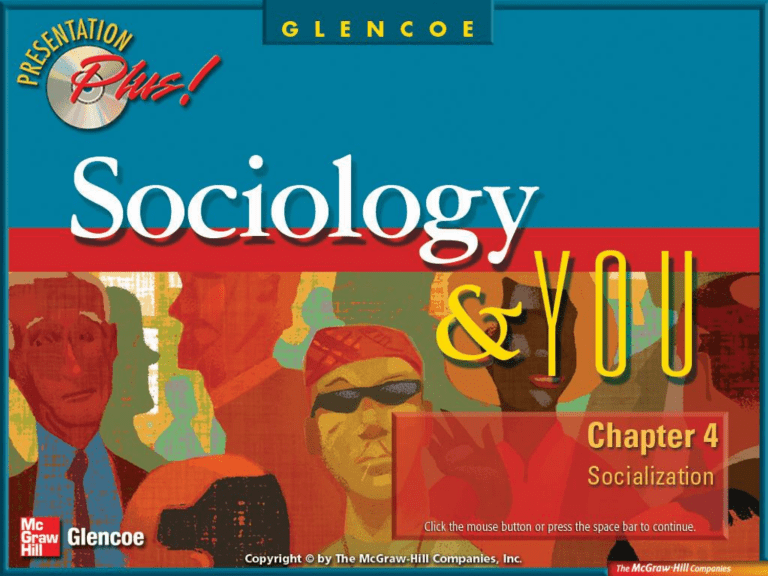
Chapter Preview Section 1: The importance of Socialization Section 2: Socialization and the Self Section 3: Agents of Socialization Section 4: Processes of Socialization Chapter Preview · Section 1 The Importance of Socialization (pages 110–114) Socialization is the cultural process of learning to participate in group life. Studies have shown that animals and human infants who are deprived of intensive and prolonged social contact with others are stunted in their emotional and social growth. Chapter Preview · Section 2 Socialization and the Self (pages 115–120) Symbolic interactionism offers the most fully developed perspective for studying socialization. In this approach, the self-concept is developed by using other people as mirrors for learning about ourselves. Chapter Preview · Section 3 Agents of Socialization (pages 121–127) During childhood and adolescence, the major agents of socialization are the family, school, peer group, and mass media. The family’s role is critical in forming basic values. Schools introduce children to life beyond the family. In peer groups young people learn to relate as equals. The mass media provide role models for full integration into society. Chapter Preview · Section 4 Processes of Socialization (pages 128–132) Desocialization is the process of having to give up old norms. Resocialization begins as people adopt new norms and values. Anticipatory socialization and reference groups are concerned with voluntary change as when moving from one life stage to another. Socialization is the cultural process of learning to participate in group life. Without it, we would not develop many of the characteristics we associate with being human. Studies have shown that animals and human infants who are deprived of intensive and prolonged social contact with others are stunted in their emotional and social growth. • socialization How important to you is interacting with others on a daily basis? A. Very important B. Somewhat important C. Not very important D. Not important at all 0% A A. B. C. 0% D. B A B C 0% D C 0% D Socialization and Personality • Socialization is the cultural process of learning to participate in group life through cultural transmission. • Harry Harlow experimented with monkeys to show the importance of affection, intimacy, and warmth. Which of the following is a result of socialization? A. A man holding a door open for a woman B. Using chopsticks to eat food C. Sitting quietly in class D. All of the above 0% A A. B. C. 0% D. B A B C 0% D C 0% D Case Studies on Isolated Children: Anna and Isabelle • Anna and Isabelle show that the personal and social development associated with being human is acquired through intensive and prolonged social contact with others. Do you agree or disagree with the following statement: Social development requires prolonged social contact with others? A. Agree B. Disagree C. Not sure 0% A A. A B. B C.0%C B 0% C All three theoretical perspectives agree that socialization is needed if cultural and societal values are to be learned. Symbolic interactionism offers the most fully developed perspective for studying socialization. In this approach, the self-concept is developed by using other people as mirrors for learning about ourselves. • self-concept • generalized other • looking-glass self • “me” • significant others • “I” • role taking • imitation stage • play stage • game stage Which group would you consider as a reflection of yourself? A. Friends B. Classmates C. Siblings 0% A A. A B. B C.0%C B 0% C The Functionalist and Conflict Perspective on Socialization • Functionalism stresses the ways in which groups work together to create a stable society. • The conflict perspective views socialization as a way of perpetuating the status quo. A person accepts his family’s social class, and thus preserves the class system. What is this an example of? A. Functionalism B. Conflict perspective C. Neither 0% A A. A B. B C.0%C B 0% C Symbolic Interactionism and Socialization • Key concepts of symbolic interactionism: – The self-concept—your image of yourself as having an identity separate from other people. – The looking-glass self—we use other people as mirrors to reflect back what we imagine they think of us. Symbolic Interactionism and Socialization (cont.) • The looking-glass self is a three-step process: – We imagine how we appear to others. – We imagine the reaction of others to our appearance. – We evaluate ourselves according to how we imagine others have judged us. Symbolic Interactionism and Socialization (cont.) • Significant others are the people whose judgments are most important to our self concepts. • Role taking allows us to see ourselves through the eyes of someone else. Symbolic Interactionism and Socialization (cont.) • This is a three stage process: – Imitation stage – Play stage – Game stage Symbolic Interactionism and Socialization (cont.) • The generalized other is an integrated conception of norms, values, and beliefs of one’s community or society. • Self equals “I” (unlearned, spontaneous acts) versus “Me” (predictability and conformity learned through socialization). Socialization and Mass Media Obsessing over the way certain people at school may view the way you dress is an example of which concept? A. The looking-glass self B. Significant others C. Role taking D. The generalized other 0% A A. B. C. 0% D. B A B C 0% D C 0% D During childhood and adolescence, the major agents of socialization are family, school, peer group, and mass media. The family’s role is critical in forming basic values. Schools introduce children to life beyond the family. In peer groups, young people learn to relate as equals. The mass media provide role models for full integration into society. • hidden curriculum • peer group • mass media From the list below, what influences your life the most? A. Parent or parents B. School C. Peer groups D. Mass media 0% A A. B. 0% C. BD. A B 0% C C D 0% D The Family and Socialization • Within the family, the child learns to: – Think and speak – Internalize norms, beliefs, and values – Form some basic attitudes – Develop a capacity for intimate and personal relationships – Acquire a self-image From the list below, who are the most influential people in you life? A. Parent or parents B. Other relatives C. Friends D. Teachers 0% A A. B. 0% C. BD. A B 0% C C D 0% D Socialization in Schools • The hidden curriculum teaches children: – discipline – order – cooperation – conformity Socialization in Schools (cont.) • These characteristics are required for success in the adult world of work. Which hidden curriculum influences you the most? A. Discipline B. Order C. Cooperation D. Conformity 0% A A. B. C. 0% D. B A B C 0% D C 0% D Peer Group Socialization • A peer group is composed of individuals of roughly the same age and interests. • In peer groups, children gain experience in: – Conflict, competition, and cooperation – Self direction – Independence from adults – Developing close ties with friends outside the family Do you think peers or family have more influence on children? A. Peers B. Family A. A B. B 0% A 0% B The Mass Media and Socialization • Mass media are means of communication designed to reach the general population, such as television, newspapers and the radio. The Mass Media and Socialization (cont.) • Positive effects: – The display of role models – Exposure to ideas about the values in their society • Negative effects: – Exposure to violence Availability of Television Which is an example of mass media? A. Television B. Newspaper C. Internet D. All of the above 0% A A. B. 0% C. B D. A B 0% C C D 0% D Symbolic interactionism views socialization as a lifelong process. Desocialization is the process of having to give up old norms. Resocialization begins as people adopt new norms and values. Anticipatory socialization and reference groups are concerned with voluntary changes, such as moving from one life stage to another. • total institutions • desocialization • resocialization • anticipatory socialization • reference group Which do you think is the greatest change in a person’s life? A. Working for a living B. Getting married C. Having children 0% A A. A B. B C.0% C B 0% C Desocialization and Resocialization • Total institutions—places where residents are separated from the rest of society. • The purpose of these places is to desocialize and then resocialize people. Rates of Imprisonment Desocialization and Resocialization (cont.) • Desocialization—the process by which people give up old norms, values, attitudes, and behaviors. • Resocialization—the process in which people adopt new norms, values, attitudes and behaviors. Which is NOT an example of a total institution? A. Military B. Prison C. College 0% A A. A B. B C.0% C B 0% C Anticipatory Socialization • Anticipatory socialization is the process of preparing (in advance) for new norms, values, attitudes and behaviors. • A group of people will use a reference group to evaluate themselves and acquire attitudes, values, beliefs, and norms. How is anticipatory socialization different from desocialization and resocialization? A. It’s a voluntary process. B. There is advance preparation. 0% C A 0% A. A B. B 0% C. C B C. All of the above Rates of Imprisonment This map shows the number of prisoners with sentences of more than one year per 100,000 U.S. residents. Source: U.S. Department of Justice, Bureau of Justice Statistics, 2005. Availability of Television Source: The World Bank, 2005 World Development Indicators. socialization the process of learning to participate in a group self-concept an image of yourself as having an identity separate from other people looking-glass self an image of yourself based on what you believe others think of you significant others those people whose reactions are most important to your self-concept role taking assuming the viewpoint of another person and using that viewpoint to shape the selfconcept imitation stage Mead’s first stage in the development of role taking; children begin to imitate behaviors without understanding why play stage Mead’s second stage in the development of role taking; children act in ways they imagine other people would game stage Mead’s third stage in the development of role taking; children anticipate the actions of others based on social rules generalized other integrated conception of the norms, values, and beliefs of one’s community or society “me” the part of the self formed through socialization “I” the part of the self that accounts for unlearned, spontaneous acts hidden curriculum the informal and unofficial aspects of culture that children are taught in school peer group set of individuals of roughly the same age and interests mass media means of communication designed to reach the general population total institutions places in which people are separated from the rest of society and controlled by officials in charge desocialization the process of giving up old norms, values, attitudes, and behaviors resocialization the process of adopting new norms, values, attitudes, and behaviors anticipatory socialization the voluntary process of preparing to accept new norms, values, attitudes, and behaviors reference group group whose norms and values are used to guide behavior; group with whom you identify To use this Presentation Plus! product: Click the Forward button to go to the next slide. Click the Previous button to return to the previous slide. Click the Home button to return to the Chapter Menu. Click the Transparency button to access the transparencies that are relevant to this chapter. Click the Return button in a feature to return to the main presentation. Click the Sociology Online button to access online textbook features. Click the Exit button or press the Escape key [Esc] to end the chapter slide show. Click the Help button to access this screen. Links to Presentation Plus! features such as the Figures, Time Lines, Snapshot of America, World View and others are located at the bottom of relevant screens.


